Find out how to tune your guitar using standard guitar tuning by following the steps below.
Standard Guitar Tuning - String Notes
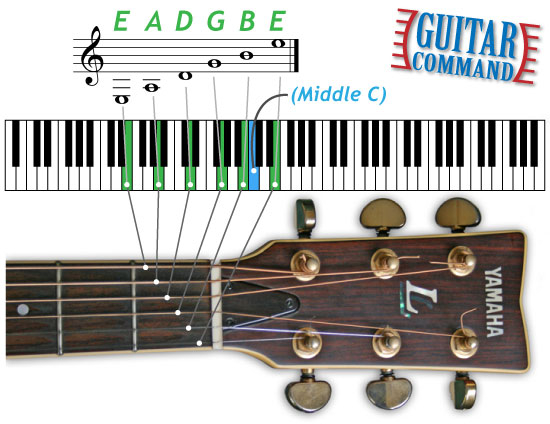
6th String (lowest-sounding & thickest String) = E
5th String = A
4th String = D
3rd String = G
2nd String = B
1st String (highest-sounding & thinnest string) = E (2 octaves higher that the 6th string)
In standard guitar tuning, the lowest (6th) string is tuned to an E. The highest-sounding string (1st string), is also an E, but two octaves higher. The other strings are tuned as shown above.
Using A Guitar Tuner
We strongly recommend that you get hold of a guitar tuner. Rather than hindering your progress, we believe that using a guitar tuner from the outset will help your ear develop faster. Being able to tune up quickly also means that you can practice for longer!
Virtually all modern guitar tuners are reliable and inexpensive. Either the Fender FT-004 or Korg GA1 will earn their place in your gear bag (follow links to view at Amazon).
Standard Guitar Tuning - Reference Pitches
If you are not using an electric guitar tuner, the guitar can be tuned in two ways: the first is by using reference notes from a piano or other musical instrument, the second is by getting the guitar strings in tune relative to themselves, without using a reference pitch.
If using the first way, the guitar strings will be at the 'right' pitch, and your playing will be in tune with all other instruments tuned to the standard pitch frequencies.
If using the second way, your guitar will sound fine when played by itself, but will not be in tune with other instruments (unless they are all tuned to the same, 'incorrect' pitches). This isn't a problem if you are playing solo, or accompanying yourself singing. However, if you are joined by other musicians, their instruments may not be in tune with your guitar.
How To Tune Your Guitar Using Standard Guitar Tuning
Follow the steps below to tune your guitar to standard guitar tuning. If you don't have another instrument to provide a reference pitch, you can skip the first step and go directly to step 2. Of course, if you have an electronic guitar tuner, you can simply play the individual strings and the device will tell you if you need to raise or lower the pitch to get them in tune.
Step 1. Play the reference pitch.
Play the low E note on the piano or keyboard, or have another musician play the note on their instrument. Using the tuners on your guitar, vary the pitch of the low E string either up or down until it is at the same note as the reference pitch. You can either play the reference note first, then adjust your tuning, or play them both at the same time (or a mixture of both). It doesn't matter if you overshoot the correct note, just tune back the other way until it sounds right.
Take your time. People who hurry this are just showing off – experienced musicians will want to get their instrument sounding just right.
Step 2. Tune The A String
Once your low E string is at the correct pitch, you can find the pitch that the A string should be tuned to by playing the low E string at the 5th fret. If you haven't got a reference instrument, just tune the A string to whatever pitch the E string happens to be (providing it is somewhere in the vicinity of the correct note). Because of the way a standard guitar works, playing the low E string at the 5th fret produces an A note; the very same note that the A string needs to be tuned to.
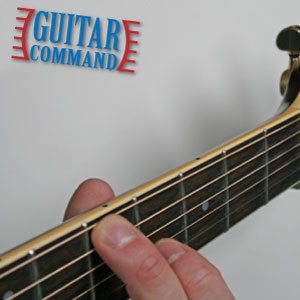
Use the machine heads to alter the pitch of the A (5th) string until it is the same as the low E (6th) string played at the 5th fret. You can either play the low string first, then play and adjust the A string, or play them both together until they sound right – or use a mixture of both.
At any stage of tuning the guitar, you can go back one or more steps if you feel that the tuning could be better, or if the strings have slipped out of tune.
Step 3. Tune The D String
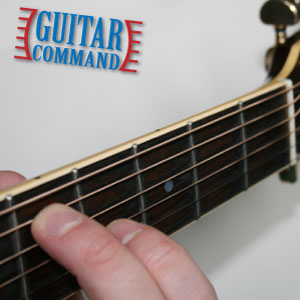
The D string is the next string up. Find the pitch that the D string should be tuned to by playing the A string at the 5th fret – this produces the same D note that the D string should be tuned to. Adjust the tuning of the D string until it the pitches are the same.
Step 4. Tune The G String
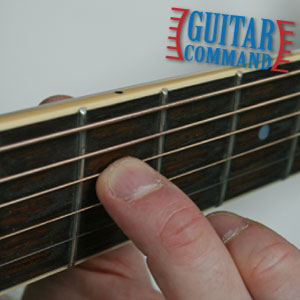
The same process is repeated to find the pitch of the G string. The note produced by playing the D string at the 5th fret produces the same G note that the G string needs to be tuned to. Adjust the string until it sounds right.
Step 5. Tune The B String
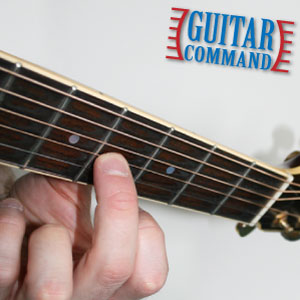
This is the same process, but with a slight change: the B string should be tuned to the note produced by playing the G string at the 4th fret. Alter the pitch of the B string until it is the same as this.
Step 6. Tune The Top E String
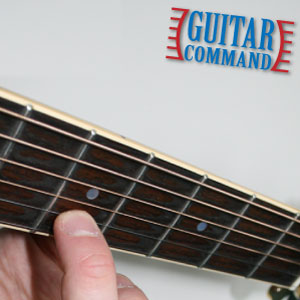
The top E string is the same note as the B string played at the 5th fret, so it's back to playing the B string at the 5th fret and adjusting the top E string so that it is at the same pitch.
Step 7. Fine Tuning
Now, test the tuning by playing some basic guitar chords. If you are lucky, the guitar will sound nicely in tune. However, most of the time the guitar will need some further fine tuning. This is because as you tune the strings the guitar neck comes under more tension, the strings can stretch, and if your guitar has a tremolo system, its springs may expand – you have to find a balance between all these elements to get the guitar in tune. Repeat all of the standard guitar tuning steps until the chords sound in tune.
Guitar Tuning Tips
While holding a chord down, raise or lower the pitch of problem strings to get them sounding in tune with the other notes of the chord. Repeat using other chords, finding a good balance between several different chords. It is actually physically impossible to get a guitar perfectly in tune, and it is a case of finding the right balance between the strings.
Tuning A Guitar To A Piano
If you have a piano or keyboard, you can of course tune each individual string to the relevant pitch, as shown in the diagram at the top of this page. However, it is very good practice to master standard guitar tuning by tuning up string by string as described in the steps above.
Mastering standard guitar tuning does not take long, and will become second nature as you progress with the instrument.


Why is the notation different on the piano and the guitar?
Hi Billy,
Sorry for the late reply, your comment somehow slipped through the net!
Guitar music is written an octave higher than it sounds. This is to minimise the use of ledger lines, making the music easier to read.
Piano music has two staffs (usually one bass, the other treble); one for each hand. The guitar doesn’t need this, as only one hand fingers the notes.
We hope this helps!
Regards,
Guitar Command Admin